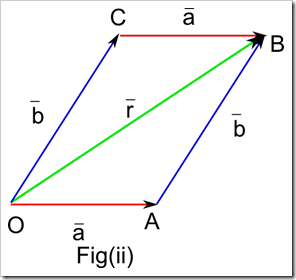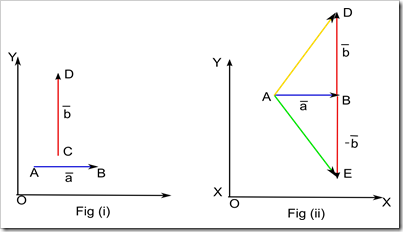Addition of vectors: If two scalars are added resulting scalar will be unique which will be equal to sum of the given two scalars.For examples if two scalars 2 and 8 are added their sum will be always equal to 2+8 =10.
But, the addition of vectors is complicated.If we add two vectors of magnitudes 2 and 8 the resultant vector’s magnitude will be 6 or 10 or any value between 6 and 10 depending on the directions of the vectors we are adding.
i) If the two given vectors are acting in same direction then the magnitude of the resultant vector will be 10 units,
ii) If the two given vectors are acting in opposite directions then the magnitude of resultant vector will be 6 units,
iii) If the two given vectors are acting in different directions then the magnitude of the resultant vector will be between 6 and 10.
How to add two given vectors(Geometrical representation): Suppose and
are two given vectors.
i)If the two vectors are acting in the same direction,take the first vector Suppose , to the terminal point of
connect the initial point of
.
We get +
=
.
The magnitude of resultant vector will be equal to the sum of magnitudes of and
i.e When two vectors are acting in same direction the “sum of the magnitudes of the vectors = Magnitude of resultant vector”
AB+CD = AD
ii)If the two vectors are acting in different directions in that case the procedure of addition will be same but the direction and magnitude of resultant vector will be different.Suppose and
are two given vectors acting in different directions as shown in the below fig(a).
To add these two vectors connect the initial point C of IInd vectors to the terminal point B of First vector
.Now join the initial point A of first vector
with the terminal point D of the second vector
.The vector
taken in reverse order
(closing side taken in reverse order) represents the resultant vector both in magnitude and direction.
I.e When two vectors are acting in different directions the “Sum of the magnitudes of the vectors > Magnitude of resultant vector”.
Laws of vector addition:
i) Vector addition is commutative +
=
+
Proof:Suppose =
and
=
are two given vectors.Now let us add these two vectors. To add
them let us connect the initial position of to the terminal point of
in anti clock wise direction,now closing side OB taken in the reverse order represents the resultant vector
.
Now draw a vectors parallel to and
and complete the parallelogram OABC.From the Fig(ii)
=
=
and
=
=
.
From triangle OAB +
=
i.e +
=
– – – – – – – – – – – – (1)
From triangle OCB +
=
i.e +
=
– – – – – – – – – – – – (2)
from eq(1) and (2) we get +
=
+
Hence vector addition is commutative.
ii) Vector addition is associative: Let =
,
=
and
=
be three different vectors.
To add the given three vectors ,
and
we have to connect the initial point of
to the terminal point of
and the initial point of
to terminal point of
.The closing side taken in reverse order represents the resultant vector.
Hence resultant =
.
Proof:To add three vectors we have to first add two vectors and to sum vector we will add the third vector.
Form fig(ii) from the triangle OAB +
=
= (
+
) – – – (1)
from triangle OBC +
=
=
– – – – – – – – – – – – (2)
substitute the value and
= (
+
) from eq(1) to eq(2)
we get ( +
) +
=
=
– – – – – -(A)
From triangle ABC +
=
i.e ( +
) =
– – – – – – – – – (3)
From triangle OAC +
=
=
– – – – – – – – (4)
solving eq(3) and eq(4) we get + (
+
) =
=
– – – – – – – (B)
Comparing eq(A) & eq(B) we get ( +
) +
=
+ (
+
)
Hence,vector addition is associative.
Subtraction of Vectors: Subtraction of vectors is also a form of addition.Addition of two vectors acting in opposite direction is called subtraction of vectors.
Suppose as in fig(i) =
and
=
are two vectors, to subtract
from
we have to add the negative vector of
to
, i.e
–
=
+ ( –
).
In the fig (ii) we have drawn = (-
) negative vector of
=
, now connect the initial point of
latex \overline{BE}$ to the terminal point of . From the resultant vector of addition of these two vectors is
.
Therefore +
=
i.e + (-
) =
–
=
.
* Subtraction of vectors is not commutative –
–








